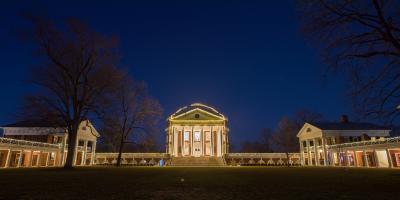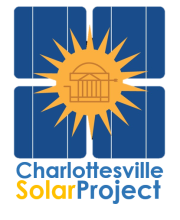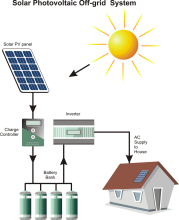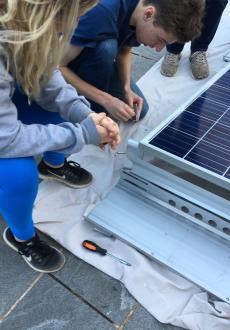Making 'Lighting of the Lawn' Solar Powered
In the Spring of 2017, I took a course called Intro to Renewable Energy Systems taught by now-retired Professor John Bean. I’ve never really liked school, but I was obsessed with this class. It was the kind of class that I could get home from final call at Trinity and start doing the reading. Bean, extremely passionate about the subject matter, always challenged his students to think analytically and put real numbers behind the sustainability movement to uncover if real business cases for renewables and an energy transformation existed. I felt they did.
Because of the class, I got an internship that summer at the Department of Energy and asked my parents to install solar panels on our house. My parents laughed in my face and without a second thought said “no.” This flustered me and I told them I could save them money but they said there was no chance I could do it unless I was a professional solar installer. After hearing this, I wrote down the top 5 solar companies in the DC Metro area according to Google and began calling all of them asking for a job as a solar installer. The first one I called picked up and gave me one.
I worked the entire summer on roofs in DC, Maryland, and Virginia installing solar panels and learned a few things: it’s pretty hot on roofs during the summer, everything that glitters is on the red line, and I am extremely afraid of heights. I also learned a thing or two about installing solar panels and making site plans. Through my work at the DOE and installing solar, I began to understand why there had been so much trouble achieving the goals of the sustainability movement. Unlike movements before it, the solutions that required to succeed in the sustainability movement are interdisciplinary in nature which makes formulating a solution much more collaborative, capital intensive, and overall difficult.
Starting the CVille Solar Project
This work led to my creation of the CVille Solar Project. The club would have different committees based on your academic and professional interests so people of all disciplines could help contribute to the sustainability movement. We would have Project Policy which would write law reviews and lobbying materials regarding renewable energy, Marketing & Outreach which would do consulting work for local Charlottesville renewable energy companies, and Project Implement for students who wanted more hands-on opportunities.
Coming up with the Idea for Lighting of the Lawn (LOTL)
Looking for ways to better use the CVille Solar Project as a platform for demonstrating the feasibility of solar to the community, I got breakfast one day in the fall of 2017 with my now LOTL co-chair, Leah Palombi, who told me that I should light up the lawn with solar panels. I immediately felt that the idea would be a hit and started applying to get grants ready to do it that year. However, I was told by a lot of people on the Lighting of the Lawn Committee and UVA Sustainability that it was infeasible in that amount of time, and to get the grants ready for next year and the system safely checked out.
First, we would take a small number of solar panels (also known as a micro-grid) and charge batteries during the daytime when there is sun. We would then discharge the batteries at night to light the lawn. This concept, which we titled “Community Demonstration Micro-Grid with Battery Bank,” was the premise of our grant applications.
How we got the materials for the array
We obtained the grants for the array from the School of Engineering and Applied Sciences Experiential Learning Fund and UVA’s Student Council for the project. We also obtained in-kind donations from Suntribe Solar, Aerocompact, and Sebring Smith at UVA’s Lacey Hall. We worked with William Evans and Sathish Anabathula to ensure that the system diagram made sense when the system was properly sized. Without the help of any of those aforementioned parties, putting the array together and lighting the lawn with solar would not have been remotely possible.
The supplies for the system included:
- 2x 6V DC Batteries (how our energy was stored)
- 4x 325 Watt Polycrystalline Panels (solar panels)
- 4x Aerocompact Solar Racking (for the panels to lay on)
- Red&Black 6 Gauge AWG Wiring
- 4 String Combiner-Box
- 40A Fuse
- 60A MPTT Charge Controller
- 4 Grounding Bolts and 20 feet of Grounding Wire (for safety)
Sizing the System
Leading up to LOTL 2018, we met a lot with the guys at Facilities Management -- Dave Roberts, Gary Mason, and Randy Spencer, who helped tell us about the electrical draw of the Lighting of the Lawn lights for the East and West Wings, as well as the Rotunda harness. The draw was approximately 980 watts, which is actually remarkably low considering most microwaves take up above 1200 watts and a microwave is so much smaller than the lawn.
Difference between solar and plugging your phone charger into the wall
In order to power the lawn, we would need a battery and inverter that could output 980W. Solar differs from regular power in that it is direct current rather than alternating current which comes out of our wall outlets. Consequently, you need an inverter that can take that direct current and turn it into alternating current (also known as DC to AC). In the picture below, note the direct current batteries on the left and the inverter which turns that power to alternating current which we can use for our lights on the right.
All the issues with the array and 5am testing
Facilities management and the Lighting of the Lawn committee were also still nervous that this wasn’t going to work and made us go through a lot of testing to make sure that it would. Like them, we did not want Lighting of the Lawn to become Darkening of the Lawn. We ran a few tests with smaller, more intense lights which mimicked the lawn and ended up blowing an inverter. To make matters worse, we kept drawing out all of the power in our batteries. As a result, the day before we did the final test for Lighting of the Lawn we went to a Professor in the E-School, Harry Powell, who looked at our system and told us that the only problem was that our connections were not smooth which essentially meant that we weren’t tightening the bolts enough. The next morning we tested the lights at 5AM and it worked. This is the picture we took after that 5AM test.
Lighting of the Lawn 2018 and changes this year
Due to the successful test, the CVille Solar Project moved forward and installed the array on the East Wing of the Rotunda, wired up the system, and got it all working. The original proposal had the array on the west wing but it instead ended up being on the east wing because it made it slightly easier to run wires. On the night of LOTL 2018, I sat back and didn’t watch the show, I instead just sat under the Rotunda to make sure that there was nothing wrong with the system. I didn’t stop holding my breath until the last song ended and the light show was over.
This year we are working with a community partner, Sun Tribe Solar to get the solar array installed again. They hope to demonstrate once again the feasibility of solar and show off their safety plan which is one of the most robust regarding the installation of solar. Sun Tribe is a relatively young company, they’ve been around for less than 10 years, but are already making huge waves in the community up and down the east coast. We are really excited to work with them this year and see what they do.
Conclusion
I think that having solar in Lighting of the Lawn is great because it shows the feasibility of a really exciting, clean, alternative energy source that can save you money. Lighting of the Lawn has been a really meaningful tradition for me but all in all when it comes down to it, Lighting of the Lawn is just an opportunity for some kids to get together, put up some lights, and celebrate the holiday season. I am grateful that renewable energy can be part of that congregation.





